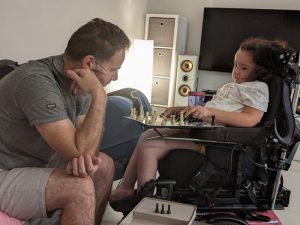During August, we recognise Spinal Muscular Atrophy (SMA) Awareness Month. SMA is a genetic condition which affects the nerves that control muscle movement (motor neurons). There is currently no cure for SMA, but various therapies and assistive technology can support those living with the condition to live their best quality of live.
Here at Hannah’s House, we support a number of children living with this condition, including 8-year-old Joanne! Joanne’s a super smart, fun and creative young girl, who we’ve had the privilege of supporting for the past two years.
We asked Joanne’s mum Christina to share a little more about what life is like for Joanne.
Can you tell us a bit about Joanne?
Joanne is a chatty 8-year-old who loves animals, going to school and interacting with her friends. Joanne is in year 3 and her favourite subject is science. In her spare time Joanne likes craft activities – especially doing origami videos and even creating her own origami and crafting videos.
Can you tell us a bit about Spinal Muscular Atrophy and what that looks like for Joanne?

Spinal Muscular Atrophy (SMA) is a degenerative genetic physical disability that affects the muscles involved in movement. The muscles weaken and waste over time. Examples of areas that are affected are walking, breathing and swallowing.
Joanne is dependent on her modified electric wheelchair for movement. She steers the chair herself using a feather touch joystick, which requires minimal effort on her part. Joanne is able to sit upright due to the laterals and head support on her chair. Due to muscle weakness, she is dependent on us for general wellbeing. Joanne’s strongest muscle is her brain. She is able to communicate verbally and express her needs.
When (and how) was Joanne diagnosed with SMA?
Joanne wasn’t reaching physical milestones from the age of seven months. This included tummy time, crawling and pushing up to walk. The local community nurse recommended that we see a physio in order to strengthen her muscles and help her in this delay. The physio conducted a series of examinations including reflex tests, reaching and movement and examining her arms and legs. She saw that there was something more serious happening with Joanne, but she wasn’t able to pinpoint exactly what. So she recommended that we see a neurologist and conduct some genetic testing.
Joanne was diagnosed at the age of 11 months with SMA through blood testing. In order to confirm this result both my husband and I had a blood test which confirmed we were carriers. There is a 25% chance that a child will be affected with SMA if both parents are carriers.
What kind of challenges does Joanne face? What kind of support does she need?

As mentioned, Joanne uses her wheelchair for movement. Our house has ramps and widened door frames to allow her to get around easily. We also have a specialised van to be able to transport Joanne. We use a hoist to transfer Joanne and she needs specialised laterals and head support on her chair to sit up straight as control is not there.
She also has foot and hand splints to help with contractures and sleeps with a BiPAP machine (a type of ventilator to used assist breathing). She has a hospital bed at home with night time positioning, as well as a special machine to help Joanne cough to ensure healthy lung health.
Joanne is PEG fed to deal with large amounts of food as swallowing and chewing is quite hard and tiring for her.
She has a standing frame which she is strapped into to be able to stand straight. It helps with bone growth, breathing and digestive health. She spends about 15 mins in this a day or as much as she can tolerate. Hydrotherapy is another recommended exercise.
Joanne uses text to speech to complete work electronically or a scribe when she is tired.
What does a week in Joanne’s life look like?
Joanne may have several hospital appointments or community therapist appointments a week. She attends school 5 days a week and has an assistant to help her set up her work, scribe, feed and toilet at school.
After school, she mainly completes homework, does crafting, makes electronic music on her iPad and reads chapter books.
She loves animals and going to The Aquarium Of Western Australia is one of her favourite activities. She also likes visiting the Zoo.
Joanne loves catching up with her cousins on the weekends.
Is there anything you’d like to wider public to understand about SMA?

30 people a year are born with SMA in Australia. No one can tell if they are carriers of SMA but anyone can go and get a blood test at any time to find out. Carriers may have no symptoms.
The quicker someone is diagnosed and the sooner they start treatment, the better it is. There is no cure for SMA.
When/how were you referred to Hannah’s House?
We were referred in 2020 through the Red Cross after they ceased their respite support.
How does Hannah’s House help support Joanne and your family – then and now?
Joanne started off with the lovely Eve, then Jess V, Emma, Jess H, and now is with Adriana. Joanne loves crafting and reading to the support workers from Hannah’s House. She loves creating plays with some of her toys and experimenting with stop motion animation.
Throughout COVID, Adriana conducts a online video session each week with Joanne and they create an origami together.
Along with physical support and care, Joanne requires a lot of mental stimulation to keep her occupied. Hannah’s House has stepped in to allow us as parents to have some time out together.




